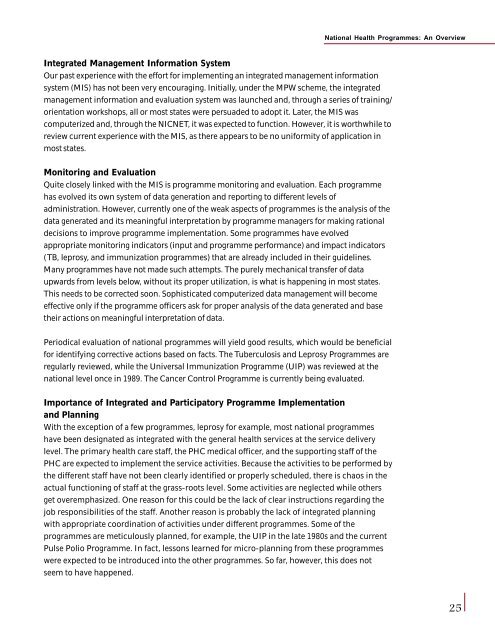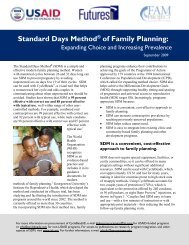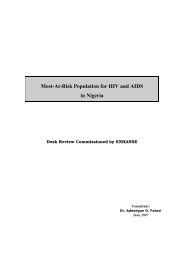Health Policy Issues and Health Programmes in ... - Amazon S3
Health Policy Issues and Health Programmes in ... - Amazon S3
Health Policy Issues and Health Programmes in ... - Amazon S3
- No tags were found...
You also want an ePaper? Increase the reach of your titles
YUMPU automatically turns print PDFs into web optimized ePapers that Google loves.
National <strong>Health</strong> <strong>Programmes</strong>: An OverviewIntegrated Management Information SystemOur past experience with the effort for implement<strong>in</strong>g an <strong>in</strong>tegrated management <strong>in</strong>formationsystem (MIS) has not been very encourag<strong>in</strong>g. Initially, under the MPW scheme, the <strong>in</strong>tegratedmanagement <strong>in</strong>formation <strong>and</strong> evaluation system was launched <strong>and</strong>, through a series of tra<strong>in</strong><strong>in</strong>g/orientation workshops, all or most states were persuaded to adopt it. Later, the MIS wascomputerized <strong>and</strong>, through the NICNET, it was expected to function. However, it is worthwhile toreview current experience with the MIS, as there appears to be no uniformity of application <strong>in</strong>most states.Monitor<strong>in</strong>g <strong>and</strong> EvaluationQuite closely l<strong>in</strong>ked with the MIS is programme monitor<strong>in</strong>g <strong>and</strong> evaluation. Each programmehas evolved its own system of data generation <strong>and</strong> report<strong>in</strong>g to different levels ofadm<strong>in</strong>istration. However, currently one of the weak aspects of programmes is the analysis of thedata generated <strong>and</strong> its mean<strong>in</strong>gful <strong>in</strong>terpretation by programme managers for mak<strong>in</strong>g rationaldecisions to improve programme implementation. Some programmes have evolvedappropriate monitor<strong>in</strong>g <strong>in</strong>dicators (<strong>in</strong>put <strong>and</strong> programme performance) <strong>and</strong> impact <strong>in</strong>dicators(TB, leprosy, <strong>and</strong> immunization programmes) that are already <strong>in</strong>cluded <strong>in</strong> their guidel<strong>in</strong>es.Many programmes have not made such attempts. The purely mechanical transfer of dataupwards from levels below, without its proper utilization, is what is happen<strong>in</strong>g <strong>in</strong> most states.This needs to be corrected soon. Sophisticated computerized data management will becomeeffective only if the programme officers ask for proper analysis of the data generated <strong>and</strong> basetheir actions on mean<strong>in</strong>gful <strong>in</strong>terpretation of data.Periodical evaluation of national programmes will yield good results, which would be beneficialfor identify<strong>in</strong>g corrective actions based on facts. The Tuberculosis <strong>and</strong> Leprosy <strong>Programmes</strong> areregularly reviewed, while the Universal Immunization Programme (UIP) was reviewed at thenational level once <strong>in</strong> 1989. The Cancer Control Programme is currently be<strong>in</strong>g evaluated.Importance of Integrated <strong>and</strong> Participatory Programme Implementation<strong>and</strong> Plann<strong>in</strong>gWith the exception of a few programmes, leprosy for example, most national programmeshave been designated as <strong>in</strong>tegrated with the general health services at the service deliverylevel. The primary health care staff, the PHC medical officer, <strong>and</strong> the support<strong>in</strong>g staff of thePHC are expected to implement the service activities. Because the activities to be performed bythe different staff have not been clearly identified or properly scheduled, there is chaos <strong>in</strong> theactual function<strong>in</strong>g of staff at the grass-roots level. Some activities are neglected while othersget overemphasized. One reason for this could be the lack of clear <strong>in</strong>structions regard<strong>in</strong>g thejob responsibilities of the staff. Another reason is probably the lack of <strong>in</strong>tegrated plann<strong>in</strong>gwith appropriate coord<strong>in</strong>ation of activities under different programmes. Some of theprogrammes are meticulously planned, for example, the UIP <strong>in</strong> the late 1980s <strong>and</strong> the currentPulse Polio Programme. In fact, lessons learned for micro-plann<strong>in</strong>g from these programmeswere expected to be <strong>in</strong>troduced <strong>in</strong>to the other programmes. So far, however, this does notseem to have happened.25







